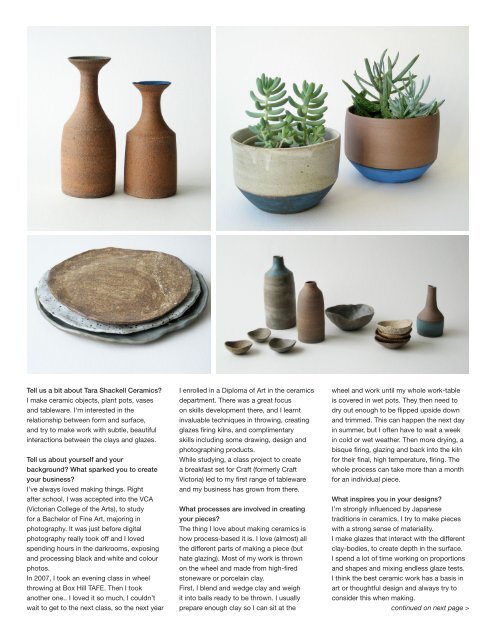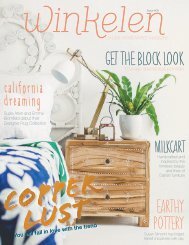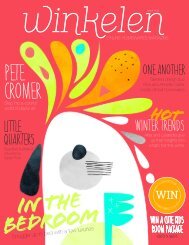intriciate collages
You also want an ePaper? Increase the reach of your titles
YUMPU automatically turns print PDFs into web optimized ePapers that Google loves.
Tell us a bit about Tara Shackell Ceramics?<br />
I make ceramic objects, plant pots, vases<br />
and tableware. I‘m interested in the<br />
relationship between form and surface,<br />
and try to make work with subtle, beautiful<br />
interactions between the clays and glazes.<br />
Tell us about yourself and your<br />
background? What sparked you to create<br />
your business?<br />
I’ve always loved making things. Right<br />
after school, I was accepted into the VCA<br />
(Victorian College of the Arts), to study<br />
for a Bachelor of Fine Art, majoring in<br />
photography. It was just before digital<br />
photography really took off and I loved<br />
spending hours in the darkrooms, exposing<br />
and processing black and white and colour<br />
photos.<br />
In 2007, I took an evening class in wheel<br />
throwing at Box Hill TAFE. Then I took<br />
another one.. I loved it so much, I couldn’t<br />
wait to get to the next class, so the next year<br />
I enrolled in a Diploma of Art in the ceramics<br />
department. There was a great focus<br />
on skills development there, and I learnt<br />
invaluable techniques in throwing, creating<br />
glazes firing kilns, and complimentary<br />
skills including some drawing, design and<br />
photographing products.<br />
While studying, a class project to create<br />
a breakfast set for Craft (formerly Craft<br />
Victoria) led to my first range of tableware<br />
and my business has grown from there.<br />
What processes are involved in creating<br />
your pieces?<br />
The thing I love about making ceramics is<br />
how process-based it is. I love (almost) all<br />
the different parts of making a piece (but<br />
hate glazing). Most of my work is thrown<br />
on the wheel and made from high-fired<br />
stoneware or porcelain clay.<br />
First, I blend and wedge clay and weigh<br />
it into balls ready to be thrown. I usually<br />
prepare enough clay so I can sit at the<br />
wheel and work until my whole work-table<br />
is covered in wet pots. They then need to<br />
dry out enough to be flipped upside down<br />
and trimmed. This can happen the next day<br />
in summer, but I often have to wait a week<br />
in cold or wet weather. Then more drying, a<br />
bisque firing, glazing and back into the kiln<br />
for their final, high temperature, firing. The<br />
whole process can take more than a month<br />
for an individual piece.<br />
What inspires you in your designs?<br />
I’m strongly influenced by Japanese<br />
traditions in ceramics. I try to make pieces<br />
with a strong sense of materiality.<br />
I make glazes that interact with the different<br />
clay-bodies, to create depth in the surface.<br />
I spend a lot of time working on proportions<br />
and shapes and mixing endless glaze tests.<br />
I think the best ceramic work has a basis in<br />
art or thoughtful design and always try to<br />
consider this when making.<br />
continued on next page >





